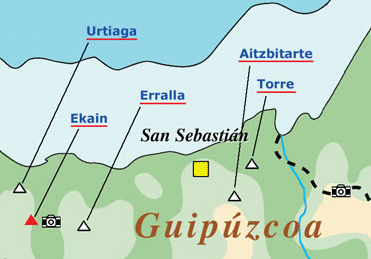Photo Archives: Paleolithic Art in Northern Spain
Ekain
Preview Edition
- 29 photos(about1280x1000,1470x980/JPEG) and the 3 variation(about1280x1000/JPEG).
- Commentary by César González Sainz & Roberto Cacho Toca, Univ. of Cantabria.
- Royality Free for private and educational use.
In this downloadable photo archives are contained 13 photos and the 4 variation of Paleolithic cave art of Ekain cave with the archeological data as shown in this preview pages. Only the small sized reference images and a part of commentary are shown in this preview edition, but if you are interested to see more and to use these photos, please go to Kagi store and purchase the data package. Once payment has been made at the Kagi store, you will receive an e-mail containing the URL to download the data package. All photos that are contained in this package are ROYALITY FREE for private and educational use.
 Ekain Cave
Ekain Cave
Cueva de Ekain contains one of the most interesting groups of cave art on the Cantabrian coast, not so much for the number of figures it has, but above all for the exceptional artistic quality of many of its paintings, and the good state of conservation of the art and its surroundings inside the cave. It is located on the eastern slopes of Ekain hill, very close to the village of Cestona, belonging to the municipality of Deba, in Guipúzcoa. The Goltzibar and Belioso brooks surround the hill, and they unite a few meters away from the cave, and form the Sastarrain rivulet, which flows into the River Urola at Cestona.
The cave is not very far from the present coast line, just seven kilometers away in a straight line. However, at the time when the cave was decorated, the accumulation of ice in the immense glaciers that existed then, resulted in a lowering of sea level. In the Cantabrian region, this meant that the coastline receded over seven kilometers to the north during the coldest periods. In any case, the cave's archaeological deposit has relatively little evidence of shell fishing. Cueva de Ekain is not an isolated site; in its surrounding area other significant Upper Paleolithic deposits are known, with particularly important occupations of the Magdalenian period (16,500 to 11,500 BP approximately). They are in the caves of Ermittia, Erralla, Urtiaga and Altxerri, and the last of these also has an important group of parietal engravings and paintings. They were used occasionally by the human populations who lived in this eastern part of the region, and whose subsistence was based on hunting red deer and ibex, and sometimes other species of ungulates, the fishing of salmon and trout in the rivers, and gathering vegetables, or shell-fish and other animals on the shore.
-------------------------------
[References]
Altuna, J., Apellániz, J. M. 1978: Las figuras rupestres paleoliticas de la cueva de Ekain (Deva, Guipúzcoa). Munibe 30, 1-3.
González Sainz, C.; Cacho Toca, R.; Altuna, J. 1999: Una nueva representación de bisonte en la cueva de Ekain (Pais Vasco). Munibe 51, pp 153-159.
|
Photographed by Takeo Fukazawa & Co-Project Team of Texnai Inc. and the University of Cantabria
Comment by César González Sainz & Roberto Cacho Toca, Univ. of Cantabria
Texnai Inc.:
2-1, Udagawa-cho, Shibuya-ku, Tokyo, Japan. Tel:03-3464-6927 Fax:03-3476-2372
e-mail:info@texnai.co.jp
Copyright reserved by Takeo Fukazawa &Texnai, Inc., University of Cantabria, IPA
|
|